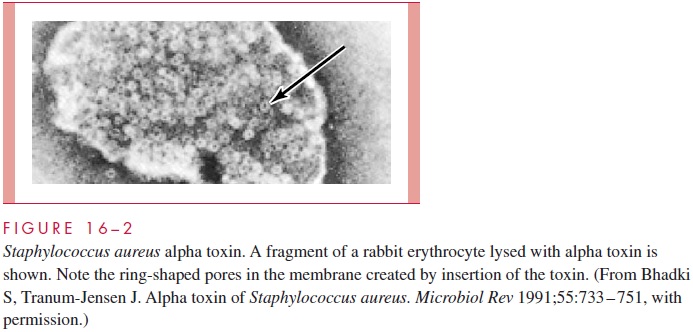Chapter: Medical Microbiology: An Introduction to Infectious Diseases: Staphylococci
Toxins and Biologically active Extracellular Enzymes - Staphylococcus aureus
TOXINS AND BIOLOGICALLY ACTIVE EXTRACELLULAR ENZYMES
α-Toxin
α-Toxin is a protein secreted by almost all strains of S. aureus but not by coagulase-negative staphylococci. It lyses cytoplasmic membranes by direct insertion into the lipid bilayer to form transmembrane pores (Fig 16 – 2). The resultant egress of vital molecules leads to cell death. This action is similar to other biologically active cytolysins such as streptolysin O , complement, and the effector proteins of cytotoxic T lymphocytes.

Exfoliatin
Exfoliatin causes intercellular splitting of the epidermis between the stratum spinosum and stratum granulosum, presumably by disruption of intercellular junctions. Two anti-genic variants of exfoliatin are antigenic in humans, and circulating antibody confers im-munity to their effects.
Pyrogenic Toxin Superantigens
The pyrogenic toxin superantigens (PTSAgs) are a family of secreted proteins able to stimulate systemic effects due to absorption from the site where they are produced by multiplying staphylococci. An individual strain may produce one or more toxins but less than 10% of S. aureus strains produce any PTSAg. These toxins share physiochemical and biologic activity similarities with each other and PTSAgs produced by group A strep-tococci . As superantigens they are strongly mitogenic for T cells and do not require proteolytic processing prior to binding with class II major histocompatibility complex (MHC) molecules on antigen-presenting cells. They interact with class II MHC molecules outside the antigenic peptide groove, and are specific for the Vβ region of the T-cell receptor. Thus, T cells with the appropriate Vβ element may be directly activated by the toxin. This stimulates both T cells and macrophages to release massive amounts of cytokines, particularly tumor necrosis factor- and interleukin-1. Other activities of these toxins are pyrogenicity and enhanced susceptibility to the lethal effects of endotoxin.
Staphylococcal Enterotoxins
The ability of S. aureus enterotoxins to stimulate gastrointestinal symptoms (primarily vomiting) in humans and animals has long been known. There are several antigenically distinct low-molecular-weight proteins in this class (eg, enterotoxin A, B, C), some of which are encoded by temperate bacteriophages.
Once formed, these toxins are quite stable, retaining activity even after boiling or exposure to gastric and jejunal enzymes. In addition to superantigen-mediated actions, they appear to act directly on neural receptors in the upper gastrointestinal tract, leading to stimulation of the vomiting center in the brain.
Toxic Shock Syndrome Toxin
Toxic shock syndrome toxin-1 (TSST-1), the major cause of staphylococcal toxic shock syndrome, shares many properties with the staphylococcal enterotoxins and was, in fact, confused with one of them during the course of its discovery. It can stimulate the release of cytokines through the superantigen mechanism, but may also have direct toxic effects on endothelial cells. The latter action may lead to capillary leakage, hypotension, and shock.
Related Topics